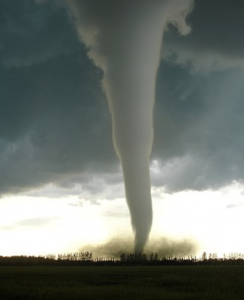It is that time of the year again where we must be on the lookout for severe storms and tornados.
Tornados can occur throughout the entire year, but April & May is prime time season for tornados. Today tornado type weather can be forecasted out days in advance and you can usually tell just how bad a ban of severe weather is going to become by learning that the Weather Channel has sent in a reporter.
A tornado is a violently rotating column of air that is in contact with both the surface of the Earth and a cumulonimbus cloud, or, in rare cases, the base of a cumulus cloud. The windstorm is also referred to as a twister, whirlwind, or cyclone.

WikiCommons photo
Most tornadoes have wind speeds less than 110 miles per hour, are about 250 feet across, and travel a few miles before dissipating. The most extreme tornadoes can attain wind speeds of more than 300 miles per hour are more than two miles in diameter and stay on the ground for dozens of miles and are strong enough to peel the roofs off houses, uproot trees and hurl heavy objects, such as cars, hundreds of feet.
Tornadoes occur most frequently in North America Stretching from west Texas to North Dakota, which can see more than 200 tornadoes each year. Tornadoes can be detected before or as they occur through the use of Pulse-Doppler radar by recognizing patterns in velocity and reflectivity data, such as hook echoes or debris walls, as well as through the efforts of storm spotters.
Not all tornadoes are easy to see. In fact, they can be invisible until they pick up dust and debris, or a cloud forms within the spinning funnel. Peak tornado season in the southern states is March through May; in the northern states, it is late spring through early summer.
Tornadoes are most likely to occur between 3-9 p.m. but can occur at any time. Often times they come with warning signs such as dark or greenish sky, produce large hail, that comes with large and ark low-lying clouds that appear to be rotating and can be heard from a distance that sounds like a loud roar similar to a freight train.
In an average year, about 1,000 tornadoes are reported nationwide, according to National Oceanic and Atmospheric Administration (NOAA). Tornado intensity is measured by the enhanced Fujita (EF) scale. The scale rates tornadoes on a scale of 0 through 5, based on the amount and type of wind damage. It incorporates 28 different damage indicators, based on damage to a wide variety of structures ranging from trees to shopping malls.
 Keven Moore works in risk management services. He has a bachelor’s degree from the University of Kentucky, a master’s from Eastern Kentucky University and 25-plus years of experience in the safety and insurance profession. He is also an expert witness. He lives in Lexington with his family and works out of both Lexington and Northern Kentucky. Keven can be reached at kmoore@roeding.com
Keven Moore works in risk management services. He has a bachelor’s degree from the University of Kentucky, a master’s from Eastern Kentucky University and 25-plus years of experience in the safety and insurance profession. He is also an expert witness. He lives in Lexington with his family and works out of both Lexington and Northern Kentucky. Keven can be reached at kmoore@roeding.comLast year in 2020 there were 1,075 tornadoes compared with 1,517 in 2019, according to preliminary estimates from the NOAA. In 2020 about 76 people perished in tornadoes compared with 42 in 2019. On April 12 -13, 30 people perished in tornadoes in Georgia, Mississippi, South Carolina, and Tennessee. Then on March 2-3, 25 people were killed in tornadoes in central Tennessee, including the city of Nashville. Tornado deaths in 2020 were the highest since 2011 when 553 people were killed in 1,691 tornadoes.
According to catastrophe modeling company RMS, insured losses in the United States from these storms average about $17 billion on average each year, nearly equal to the losses incurred by hurricanes. While scientists cannot say that these storms are increasing, it is clear that the losses are increasing, as a result of population growth and economic development.
According to the most recent data from the year 2019, Kentucky ranked 22nd registering a total of 28 confirmed tornados.
Here are some helpful tips to help you survive a tornado:
Before a Tornado Strikes
Check with your insurance agent to make sure that you are adequately protected to insure the costs of a tornado.
Create a family tornado plan that includes where you will seek shelter when a tornado warning is given and where you will meet after the disaster in case you get separated. Practice your family’s tornado plan at least once per year.
Gather items that can protect you — such as mattresses, sleeping bags, and thick blankets — and place them near your shelter area.
Create an emergency kit with a first-aid kit, bottled water, nonperishable food items, flashlights, and a battery-operated radio.
Keep an ear to the radio or television and listen for storm updates.

During the Tornado
Go to the basement or lowest level of your home, get under a sturdy structure, then cover yourself with protective materials.
Crouch down to the floor facedown and cover your head with your hands.
If you live in a mobile home, leave your house and seek another shelter. If there is nowhere else to go, lie flat on the ground and cover your head with your hands.
Do not leave your safe space until local authorities say it is safe to do so.
When the tornado is over, stay with your loved ones until emergency personnel arrives. Keep away from power lines and any puddles near fallen wires, as they could still be carrying electricity. Be sure to watch your step for broken glass, nails, and other sharp objects that may have flown around during the storm. Do not enter heavily damaged buildings, as they could collapse at any time.
Lastly, make sure you assess your home for any damages that the tornado caused and reach out to your insurance agent to file a claim as quickly as possible.
Be Safe My Friends!





















